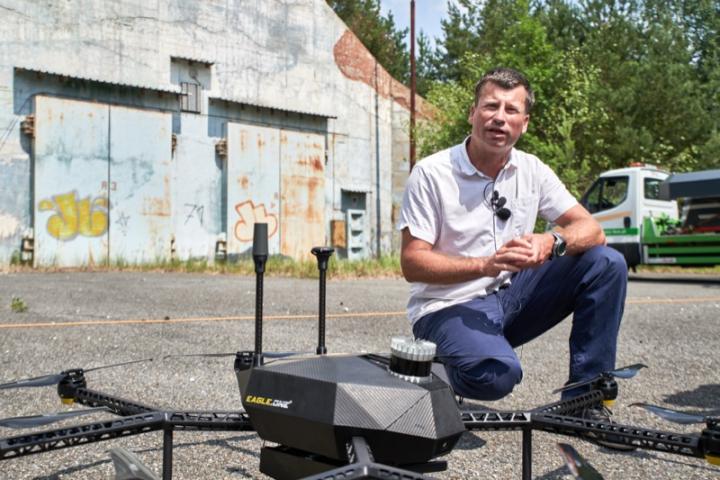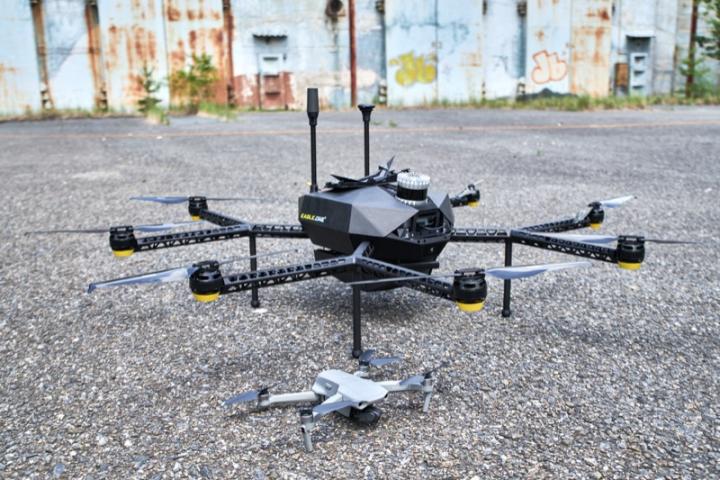
The Prison Service of the Czech Republic is providing a test area for the system, which is being developed by a consortium of EAGLE.ONE (trapping drone), VOJENSKÝ TECHNICKÝ ÚSTAV (drone), BizGarden (integration), Dronehub (hangar), FLY4FUTURE (communication software). Scientists from the Multirobotic Systems Group of FEL CTU are involved in the artificial intelligence component. Eagle.One was presented, among other things, at the EXPO 2020 world exhibition in Dubai, where it was one of the most attention-grabbing exhibits. Interest in its use comes literally from all over the world.
The moving component of the system performing the actual physical intervention is a large eight-propeller Eagle.One drone. It can normally be on standby 365 days a year in a protected hangar, which provides all the conditions it needs - from the right temperature to recharging its batteries. The ground component of the system is a localization unit composed of 3D lidar (lidar is a method of recognizing the surroundings based on the reflection of a pulsed light beam). It protects the perimeter of the guarded object, and if it detects a suspicious flying object, the intervention drone is activated. The Eagle receives the appropriate instructions and is airborne within seconds.
Artificial intelligence is used to detect the flying object itself and to assess its danger. Several entities are involved in its development. On-board target detection and optimal drone control come from the laboratories of the Faculty of Electrical Engineering (FEL). Information obtained from ground-based security cameras and lidars is transmitted in real time to Eagle for initial guidance of the flying robot to the area of intervention. In addition to the trapping equipment, Eagle.One has additional 3D lidar, its own computer and artificial intelligence on board. In emergencies, such as when communication with a ground unit is broken, Eagle.One can make decisions completely autonomously. The strategic planning of the intervention itself also takes place on board the robotic Eagle.
The basis of the system is a mobile hangar for drones developed by the Polish company DRONEHUB within the AUDROS project. The project is being implemented with the financial support of the European Space Agency (ESA) and the European Defence Agency (EDA). "Our cooperation with the European Space Agency has been ongoing since 2020, when we started to develop an autonomous system with drones for the detection and elimination of CBRNE (chemical, biological, radiological, nuclear, explosive) threats," says Jan Orava, a representative of BizGarden. "Today, we have a hangar that keeps the drone in a charged state and, in case of emergency, enables automatic launch of the drone in a matter of seconds," adds Jan Orava.
The actual intervention begins when the Eagle.One drone is close enough to the intruder. At the beginning of the trapping process, a bulky trapping net is deployed. The drone's flight is planned to optimally disable the target by trapping it in the net carried in the suspension.
If Eagle.One or a cooperating ground-based location system detects another target, the drone can continue to pursue the first intruder in the network. Of course, only after its artificial intelligence assesses that this is technically possible (e.g. due to the size or expected weight of the second target).
"At the Faculty of Electrical Engineering of CTU, we are also working on the possibility of multiple flying robots autonomously cooperating simultaneously to capture a target or group of targets. They would know about each other and their movements and next steps and would coordinate the intervention against the target. Artificial intelligence could thus play a similar action with a group of drones as when a pack of wolves attacks its prey," explains doc. Martin Saska, head of the Multirobotic Systems Group at FEL CTU.
According to him, one of the biggest advantages of the introduced system is the safe neutralisation of the intruder. "This is because if an intruder drone is shot down, e.g. by a shotgun or electromagnetic cannon, a disaster can occur if the drone is carrying explosives or other dangerous substances. The Eagle.One with the captured target can gently land in a safe place, which is determined in advance, for example, by bomb technicians," adds doc. Saska.
The system can provide invaluable services in protecting critical infrastructure. This could be, for example, nuclear power plants or prisons where drugs, mobile phones or weapons are smuggled in by drones. But the system can also be involved in the protection of important people, such as presidents, celebrities and so on.
Drones are a huge security threat today. With minimal resources, it is possible to acquire a highly effective and efficient weapon that can repeatedly cause tens of millions of dollars in damage to life and property. Protecting against unwanted unmanned flying vehicles is and will be a very hot topic.
Eagle.One has eight propellers, weighs about 15 kilograms, is technically capable of reaching an altitude of several kilometres above the ground and has a top speed of 83 km/h.


foto: P. Neugebauer, SVTI